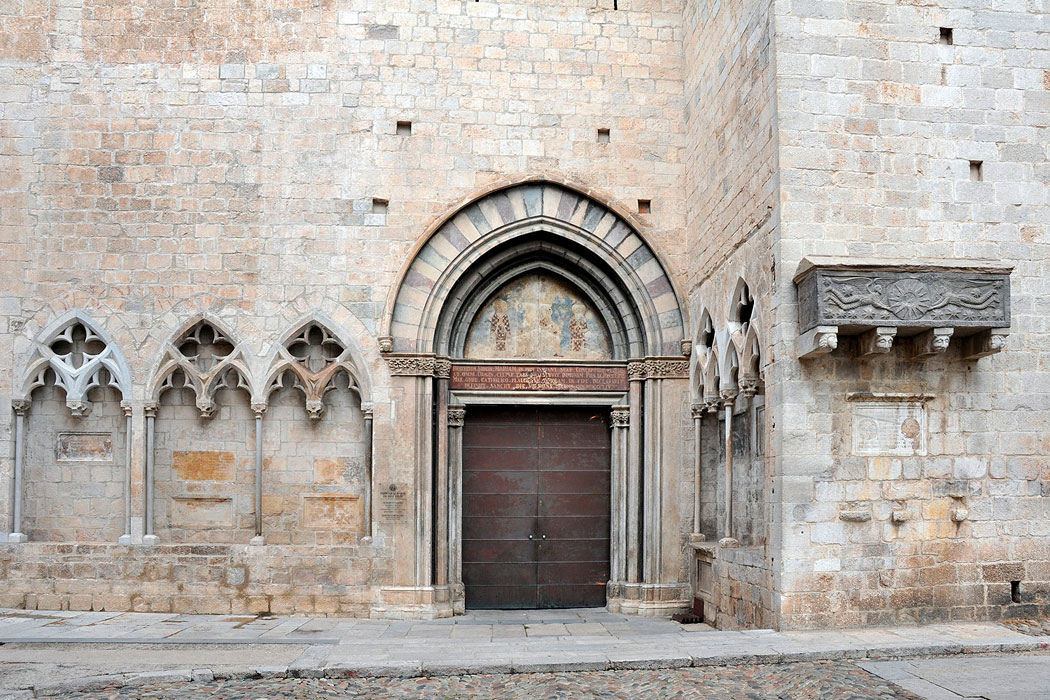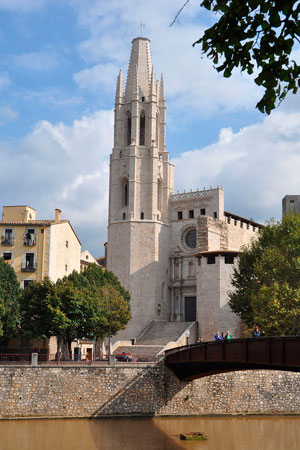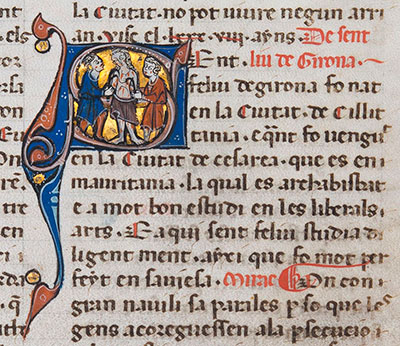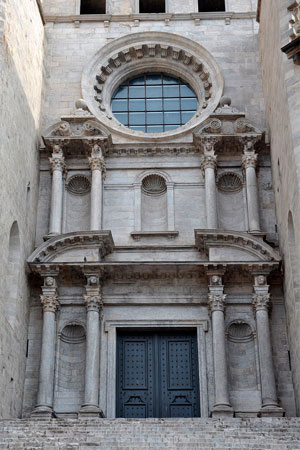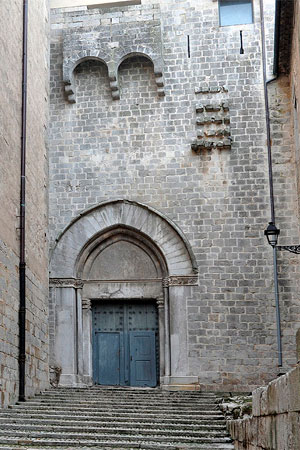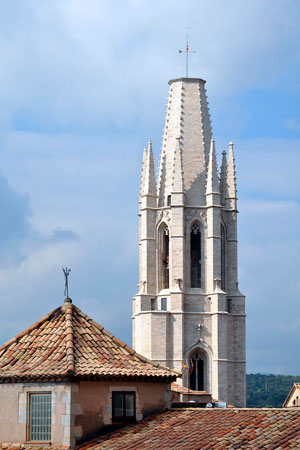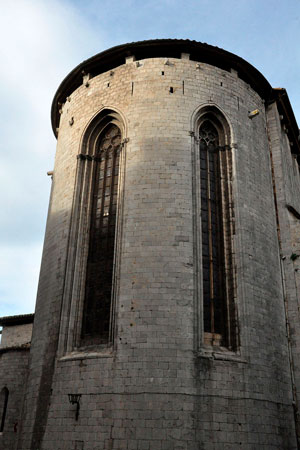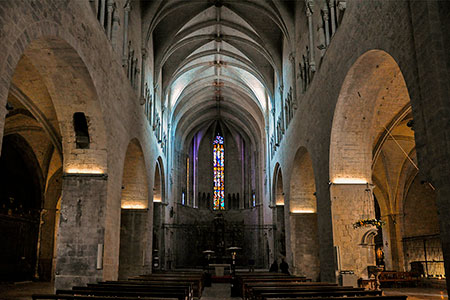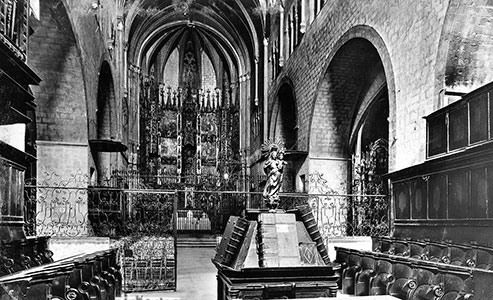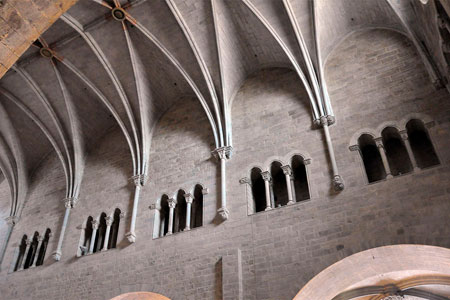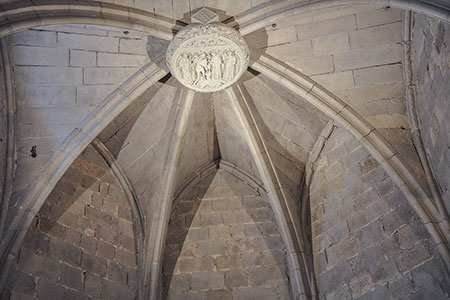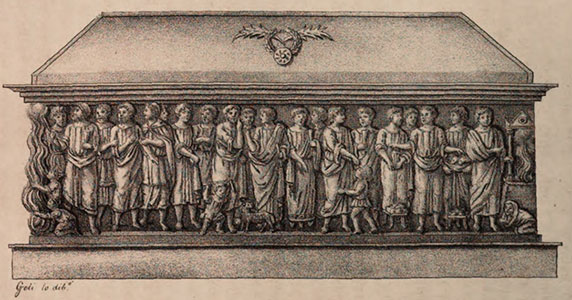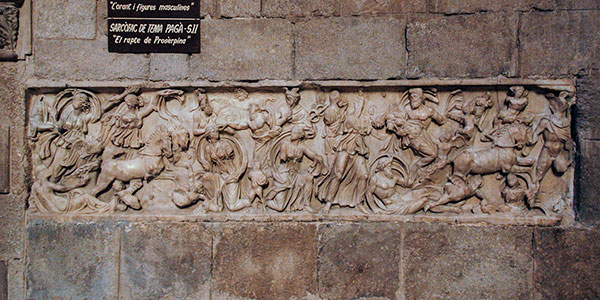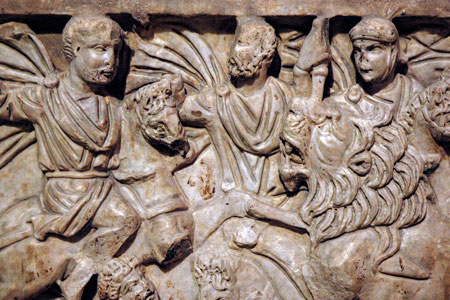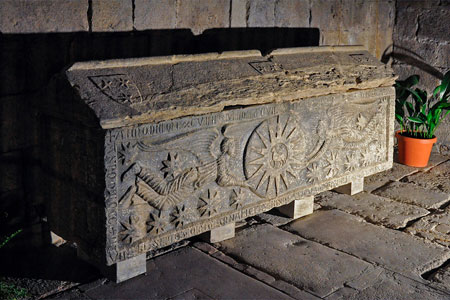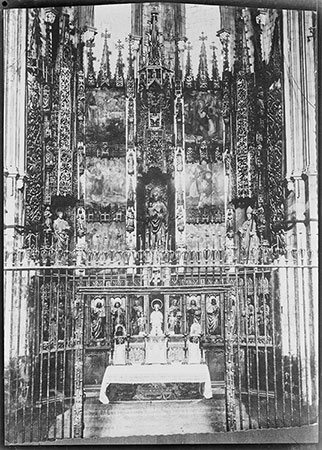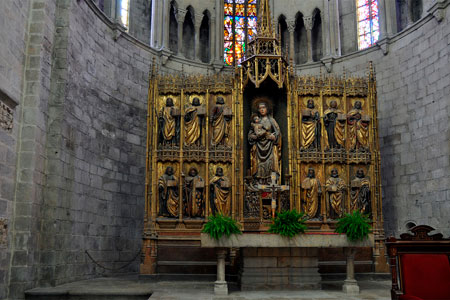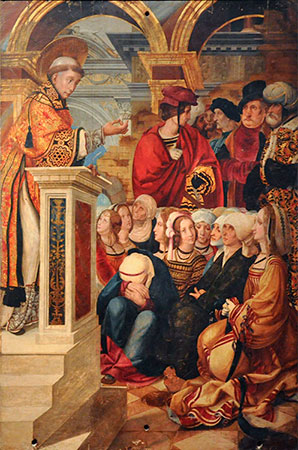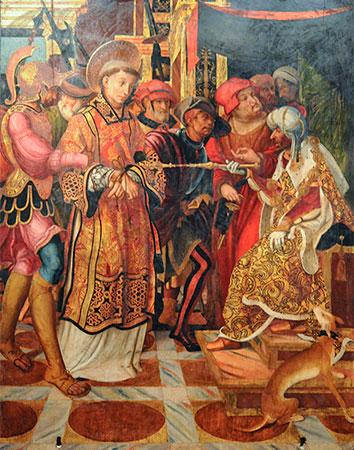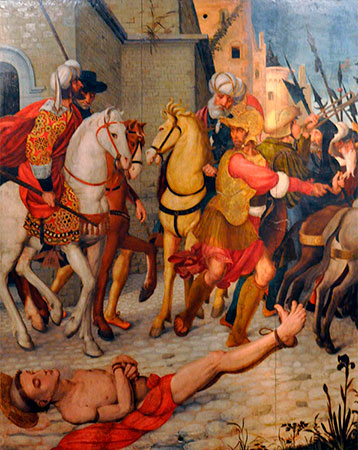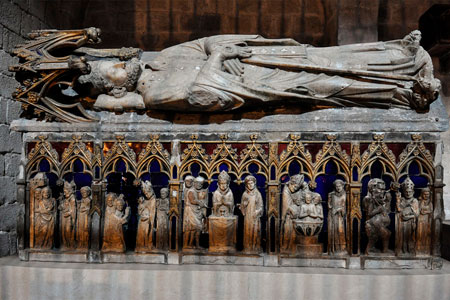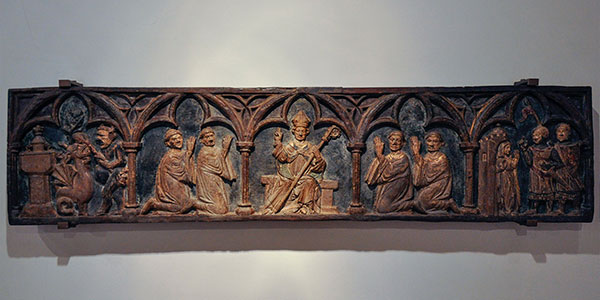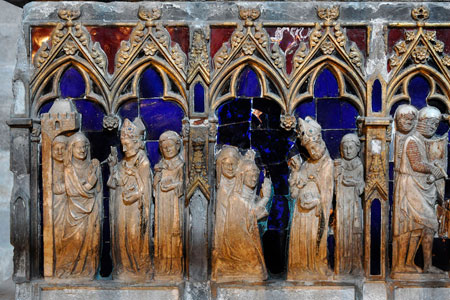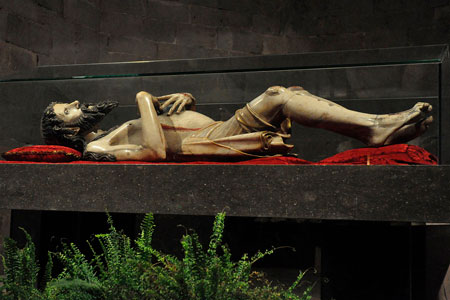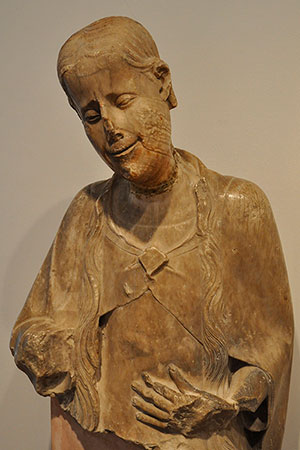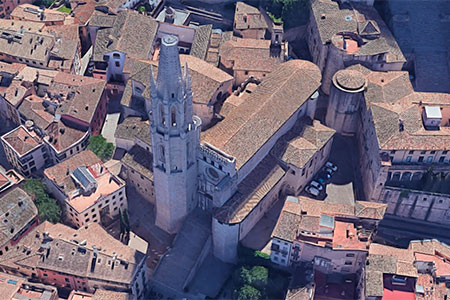Canonry of Sant Feliu de Girona
Collegiate Church of St. Feliu / Sant Fèlix / Sancti Felicis
(Girona, Gironès)
The church of Sant Feliu has been known since ancient times thanks to the devotion aroused by the relics of the martyr Saint Felix the African (Felix of Girona), buried in this place, which would later be occupied by the church. Later, devotion to Saint Narcissus (Narcís of Girona) was added; in 1002 Pope Sylvester mentioned the relics of this saint, which were venerated in the city.
As time went by, this devotion grew stronger, and a community of canons gathered around the figure of the saint and the place of devotion developed at the site of his martyrium. The evolution of the canonry of Sant Feliu is full of questions and is confused with that of the Cathedral. It has been assumed that there were two canonries in Sant Feliu, one of Visigothic origin and the second, that of Santa Maria, promoted by the Carolingians after they took over the city in 785. Initially, it was the cathedral seat and residence of the bishop, in this sense, the epitaph of bishop Serfdedéu, from 906, is still preserved in Sant Feliu.
Feliu of Girona, Felix, or Feliu the African
Sant Feliu is a Girona martyr of North African origin who died, most likely in the current Mercadal neighbourhood of Girona, during the Diocletianic Persecution, at the beginning of the 4th century. It is also believed that he was martyred in Sant Feliu de Guíxols. He was buried outside the walls of Girona, where a primitive construction, or martyrium, was erected in his memory. That funerary temple would be expanded over time to the current basilica of Sant Feliu, near the Sobreportes portal.
The transfer of the community of canons of Santa Maria to the cathedral built within the walls is also confusing, probably influenced by the fact that Sant Feliu was located outside the wall, with the inconveniences that this represented. This separation could perhaps be placed around 1020. In 1038 the cathedral of Santa Maria was consecrated, and it was probably at that time that the canonical see developed around it, although it was probably already active in the 10th century.
The first known abbot of the canonical see of Sant Feliu is Teudesind, mentioned in 949. Despite being independent, the community of Sant Feliu was closely related to that of Santa Maria, and in 1337 they had the need to prohibit the canons from belonging to the two communities at the same time. The strength of the place began to decline from the 16th century onwards until in 1835 it was extinguished and became a parish church. The current church of Sant Feliu is a Gothic work, a building that was erected during the 14th century on top of other constructions from earlier times, from the modest martyrium, later extended, especially during the 12th and 13th centuries, and in the Baroque period.
The tombs of the chancel
In the chancel of Sant Feliu, there is a valuable set of eight sarcophagi embedded in the walls, which are traditionally believed to have been recovered from the same area of the church, where there was an ancient necropolis. Mention should be made of the sarcophagus known as the Sarcophagus of Saint Felix, which was previously located at an altar and moved to its current location in 1943. In a side chapel, there is also the Sarcophagus of the Sitjar Family, featuring two angels holding a sun, with an inscription dated 1214. This sarcophagus was formerly located outside, next to the southern entrance.
Altarpiece of the High Altar, dedicated to Saint Felix
Between 1504 and 1520, a large altarpiece was constructed, which presided over the chancel until it was dismantled in 1936. Today, the altarpiece is preserved in parts: a significant portion is held at the Museu d'Art de Girona, while other elements remain in Sant Feliu, reassembled into a smaller piece of furniture. Several artists contributed to its creation: Joan Venetrica, Pere Robredo, and Joan d’Aragó were responsible for the sculptures, while the smaller painted panels of the predella were done by Pere de Fontanes. Joan de Borgonya created the six large panels depicting scenes from the life and martyrdom of Saint Felix, painted between 1518 and 1520.
Tomb of Saint Narcissus
Joan de Tournai created the Tomb of Saint Narcissus between 1326 and 1328, which is still preserved in the church. It consists of the recumbent figure of the saint on top of the tomb, and a series of scenes from his life on the front. This piece had an opening at the back, through which the saint’s body could be viewed. This opening was closed with a polychrome wooden cover, which is now preserved at the Museu d'Art de Girona.
The Chapel of Saint Narcissus and the lost cloister
The canonry also had a Romanesque cloister, which was destroyed during the siege of 1285 and rebuilt in the 14th century in the Gothic style. This cloister was demolished again for defensive purposes in 1374. It is possible that the arcades on the southern façade originated from this location. Today, that space is occupied by the Chapel of Saint Narcissus, built in the 18th century.
Works preserved outside the Basilica
At the Museu d'Art de Girona, there is a chest with ivory plaques, possibly of Sicilian origin, which once belonged to the canonry of Sant Feliu. Also, from the same origin and current location is the Homiliary of Beda, a valuable illuminated manuscript, possibly produced at the scriptorium of Ripoll or Vic, which is dated to the second half of the 11th century.
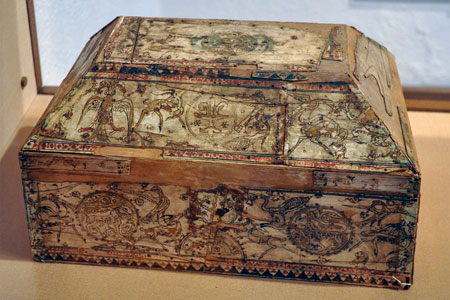
Ivory chest (13th century)
Museu d'Art de Girona
- AMICH, Narcís M. (2007). Felix de Gerunda: origen i evolució d’un culte gironí a l’antiguitat tardana (S.IV-VII). Revista de Girona, núm. 240
- AMICH, Narcís M.; NOLLA, Josep M. (2001). El "sarcòfag de Sant Feliu”. Una aproximació historicoarqueològica. Annals de l’Institut d’Estudis Gironins, núm. 42
- CANAL, Fr. José de la (1832). España Sagrada. Vol 45. Madrid: Imp. José del Collado
- CANAL, Josep; i altres (2003-2004). Història Urbana de Girona. Vol. 5 i 6. Girona, de Carlemany al feudalisme (785-1057). El trànsit de la ciutat antiga a l’època medieval. Ajuntament de Girona
- CHAMORRO, Miquel Àngel (2007). La construcció de l’església de Sant Feliu de Girona. Revista de Girona, núm. 240
- CLARA, Josep; MARQUÈS, Josep M. (1992). Sant Feliu de Girona. Parròquia de Sant Feliu de Girona
- FREIXAS, Pere (2016). La basílica de Sant Feliu. Primera catedral de Girona. Ajuntament de Girona
- GAVÍN, Josep M. (1982). Inventari d'esglésies. Vol. 10. Gironès, Selva. Barcelona: Arxiu Gavín
- LORÉS, Immaculada (1988). Sant Feliu de Girona. L'escultura romànica del trifori. D'art
- MARQUÈS, Josep M. (2007). Una història de la diòcesi de Girona. Bisbat de Girona
- MARQUÈS, Josep Maria (2007). Sant Feliu versus Sant Narcís. Revista de Girona, núm. 240
- NOLLA, Josep M. (2007). La ciutat tardoantiga de Gerunda, bressol del cristianisme gironí. Revista de Girona, núm. 240
- NOLLA, Josep M.; PALAHÍ, Lluís (2011). Els orígens de la basílica de Sant Feliu de Girona. Dades documentals i arqueològics. Estat de la qüestió. Universitat de Girona
- PRATS, Lluís (1990). El sarcòfag de Prosèrpina de l’esglèsia de Sant Feliu (Girona). Faventia, núm. 12
- ROURA, Gabriel (1988). Girona carolíngia. Del 785 a l'any 1000. Diputació de Girona
- SANZ, Antoni (1991). Sant Feliu de Girona. Catalunya romànica. Vol. V. El Gironès, la Seva, el Pla de l’Estany. Barcelona: Enciclopèdia Catalana
- SUREDA, Marc (2007). Sant Feliu: mil anys en imatges. Notes a la iconografia de Sant Feliu de Girona. Revista de Girona, núm. 240
